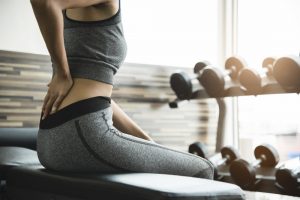Exercise technique is often a hot topic of discussion in the fitness industry. It invokes a lot of confusion and questions such as, “What exactly is “proper technique?” or “Does form actually matter?”
Before discussing why form is important, we need to determine an appropriate definition for the term “exercise technique”. For this article, we can define it as procedures provided by governing institutions. Such organizations include the National Academy of Strength and Conditioning (NSCA), the American College of Sports Medicine (ACSM), and the National Academy of Sports Medicine (NASM).
If there is a proper way to conduct an exercise, why does it even matter?
There are plenty of people who sweat, have fun, and get results regardless of their exercise technique. Eager beginners spend plenty of time practicing push-up form that could give your personal trainer a conniption. So why is exercise technique so important?
While there might be some situations where breaking technique is warranted, they are very seldom. Here are a few reasons why exercise technique is tantamount to a safe and highly-effective training program:
Reduce Chances of Immediate Injury
Have you ever incurred a sudden injury that could have been prevented with better attentiveness to technique? Even if it resulted in just an ankle sprain or nagging pain in your shoulder?
Technique plays a vital role in reducing the occurrence of an immediate injury. Note that I did not mention prevent chances of injury. There is always a chance for injury unless your life consist of sitting in a chair and staring at a wall all day.

However, most people are actively performing tasks daily, such as reaching overhead into their cabinets or picking up their kids before they swallow their Lego set.
Integrating functional exercises in your training and performing them properly might reduce your chance of injury outside of the gym. “Functional exercise” or “functional training” consists of movements you perform in activities of daily living. Functional exercise is a popular term used in the fitness industry as it places more importance on functionality than merely improving aesthetics. While “functional training” can vary from person to person, a lot of movements patterns overlap, such as squats and lunges. The value of exercise for health and well-being is even greater when considering how it helps us move efficiently daily.
By developing optimal movement patterns with exercise, you can solidify your form so it becomes a habit in everyday living activities. Practicing consistently allows you to form habits of performing quality movement and reduce chance of compromising your position. Twinging your back or shoulder is less likely when practicing effective movement strategies in a controlled environment.
Reduce Chances of Future Injury
Have you ever heard, “You are what you eat” or “You are what you repeatedly do”?
Building a proper foundation of movement quality and posture is important as our body can redesign itself based on the movements we perform regularly. You might experience a nagging pain in your back when performing a squat or lunge due to a long-term culmination of imbalances and dysfunctional movements. Perhaps you continue until it subsides during your workout. However, the underlying problem is left unresolved.
Imagine getting a shot to relieve pain in your lower-back. The shot helps you acutely alleviate your pain, allowing you to function, but it does not address the root of the problem. Oftentimes, people will use “shots”, running into the same pains over and over again, because something remains unchanged. As Einstein said, “The definition of insanity is doing the same thing over and over, expecting different results”.
Practicing the same movements repetitively without mindfulness to quality technique could perpetuate into a cycle of injury.
The Cumulative Injury Cycle
The cumulative injury cycle refers to the process of the compounded stress to the human body over time from poor posture and repetitive movements. Faulty movement patterns and postures practiced over time can lead to muscular imbalances, ultimately causing stress on the kinetic chain (the concept of what occurs in one area of the body can affect another segment), eventually resulting in injury (1).

An example of practicing a movement pattern that can ultimately turn into an injury is the deadlift. The deadlift is one of the most effective full-body exercises, developing your core and entire backside. Additionally, you develop the practice of safely lifting objects. However, without proper progression and execution, this movement has the potential to be dangerous. If you repeatedly perform it resembling a scared cat, you are more likely to injury yourself eventually (if not immediately). If you regularly pick up objects in your occupation or daily activities, you are continuing to ingrain these patterns. These actions can be mechanically stressful on the body and cause a cycle of trauma until interrupted.
Greater Performance and Effectiveness of Exercise
How does injury prevention affect performance?
First, depending on the severity of the nagging pain or injury, you might not have any performance to begin with! How can you perform optimally if you are dealing with an injury? How can you sprint at maximum speed when you twinged your knee during a poorly performed warm-up exercise?
Increasing Exercise Effectiveness
Second, better exercise technique allows you to feel the intended area(s) with less compensation from other muscles and benefit more from each exercise.
If you can feel the muscle engaged as intended, you might have a better chance in developing that area. Want bigger glutes? You would want to feel them working when performing an exercise then, right?
You might have heard the term “mind-muscle connection” in bodybuilding circles. The mind-muscle connection consists of focusing on a particular muscle to increase activation in the desired region. Studies have confirmed that the mind-muscle connection is indeed real and you can activate a muscle more by focusing on the targeted region (2). With better technique which comes along with more concentration on targeted muscle(s), you are more likely to experience a greater benefit of the exercise. This can complement utilizing the prescribed form when trying to activate and strengthen the muscle(s) intended for the exercise.
The glute bridge is a popular exercise that can help activate and strengthen your glutes. The primary muscle involved, the gluteus maximus, is one of the strongest muscles in the human body and is crucial to athletic performance. Weak gluteals can lead to injury in high-stress situations and a decrease in performance (3). Consequently, in many programs, it is used to decrease the incidence of low-back pain, among other injuries or irritations (4). However, if you perform the movement improperly, you can limit glute activation and contribute to discomfort in the low-back. For instance, foot placement or overarching at your low-back could make gluteal engagement less likely. Instead, by bracing your core with the knee bent in a more optimal position, the movement is likely more effective.
Greater Movement Efficiency
Lastly, improving your exercise technique can enhance performance by moving with greater efficiency. This can transfer to sports performance. In a myriad of sports, a significant advantage is granted to the athletes who can get from point A to point B most efficiently.
One of my greatest personal realizations within Powerlifting is how much of a difference improving technique can make. Of course, you still need a prerequisite amount of strength. Do not expect to instantly Bench Press 500 pounds if you are only currently capable lifting 200 pounds. After building a certain foundation of strength, even minor adjustments to your technique can make your movement more efficient to lift heavier loads.
Action Steps
Exercising with attentiveness to technique includes benefits that include potentially, reducing immediate injury, decreasing future injuries, and improving the effectiveness of each exercise. Now what can you do to improve your technique?
There are two key strategies that you can use to dramatically improve your form: feedback and mindfulness.
Feedback
The first strategy you can use to improve your form is feedback. Feedback can be provided in the form of a gym partner or a mirror. With both, you receive instant feedback and make adjustments. Another option is recording a video of yourself to view and comparing to your intended standard.
Ensure also that you are receiving proper feedback on what to improve. While the old “practice makes perfect” adage is useful to solidify technique, it becomes counterproductive if you are performing an exercise incorrectly. When movement patterns are impaired and practiced repeatedly the result is returning to the same place we were when we started, or worse. Be sure to start changing these patterns with the right feedback along with consistency and patience.
Mindfulness
The second method, and one of the greatest ways to cultivate awareness of your body positioning throughout your exercises is practicing mindfulness.
The practice of mindfulness has recently gotten a lot of attention due to its many science-backed benefits, including stress reduction, improved attention, and anxiety (5). Meditation can help to counter many of the external distractions that position our attention away from our own self-awareness. This includes our awareness of our body positioning while performing exercises. This also can tie into the mind-muscle connection to improve targeted muscle activation.
There are a myriad of affordable programs and apps available such as Headspace that include a guided mindfulness program. Many programs have free trial options to test drive the program.
Try practicing mindfulness for designated length of time and assess how you feel afterward. Most programs will suggest you start with a short amount of time, like five or ten minutes, and gradually build your stamina.
Plenty of issues can be prevented or reduced by starting your program with a full evaluation. Assessments can include a screening of your movement patterns and joint range-of-motion. From there, specific exercises can be provided in a progressive fashion as a strength training and/or corrective exercise program. Being proactive enables you to reach your fitness and health goals as safely and efficiently as possible.
Feel free to contact me at justin@tjcperformance.com if you or a friend have any further questions about this or any other nutrition or fitness-related questions.
References
1. Clark MA, Lucett SL. NASM Essentials of Corrective Exercise Training, Baltimore,
MD: Lippincott Williams & Wilkins; 2011.
2. Calatayud, Joaquin & Vinstrup, Jonas & Jakobsen, Markus & Sundstrup, Emil & Brandt, Mikkel & Jay, Kenneth & Colado, Juan Carlos & Andersen, Lars. (2015). Importance of mind-muscle connection during progressive resistance training. European journal of applied physiology. 116. 10.
3. Leetun DT Ireland ML Willson JD, et al. Core stability measures as risk factors for lower extremity injury in athletes. Med Sci Sports Exerc. 2004;36(6):926-34.
4. Jeong U-C Sim J-H Kim C-Y, et al. The effects of gluteus muscle strengthening exercise and lumbar stabilization exercise on lumbar muscle strength and balance in chronic low back pain patients. J Phys Ther Sci. 2015;27(12):3813-3816.
Hoge E. A., Bui E., Marques L., Mecalf C. A., Morris L. A., Robinaugh D. J., et al. (2013). Randomized controlled trial of mindfulness meditation for generalized anxiety disorder: effects on anxiety and stress reactivity. J. Clin. Psychiatry 74 786–792.




